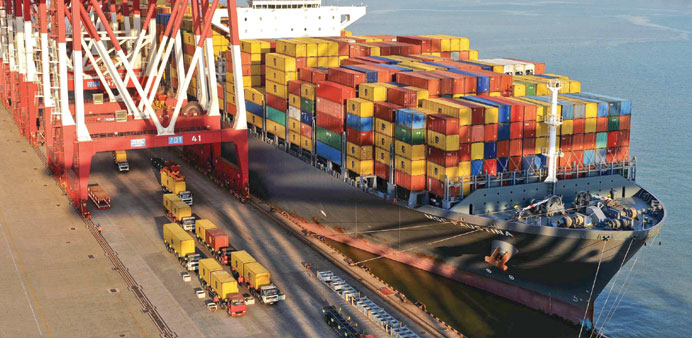Trucks carry containers that were unloaded from a ship at a port in Qingdao, Shandong province. China’s exports likely recovered in February after a grim January reading, a Reuters poll showed yesterday.
Reuters/Beijing
China’s exports likely recovered in February after a grim January reading, a Reuters poll showed, but inflation remained anaemic, keeping pressure on policymakers to roll out more support measures to meet new economic targets.
Premier Li Keqiang said yesterday that the government would target growth of around 7% this year, down from 7.4% in 2014 and signalling the slowest expansion for a quarter of a century.
A cooling property market, excess manufacturing capacity, deflationary pressures and a continued crackdown on corruption are all expected to weigh on the economy in 2015, prompting further cuts in interest rates and bank reserve requirements.
The median forecast of 16 analysts showed annual export growth probably shot up to 14.2% on an annual basis in February, recovering from a 3.3% contraction in January that surprised analysts.
Imports are seen declining again, however, dropping 10% – an improvement compared to a plunge of 19.9% in January that shocked markets, but still highlighting stubborn weakness in domestic demand. The data will be released on Sunday.
Data out of China during January and February is typically skewed by the timing and impact of the Lunar New Year holiday, making it hard to assess the trends in the world’s second-largest economy.
The forecasts follow both official and private purchasing managers’ surveys earlier in March which showed February manufacturing activity recovering slightly but remaining weak.
“Activity growth since the start of 2015 has likely been weak - weak enough that despite the low base from early 2014 year-on-year growth of most activity indicators will likely fall,” said Goldman Sachs analysts in a research note.
Inflation estimates suggested that Chinese companies continue to struggle with sliding prices even as the real cost of capital remains high, a further disincentive to investment.
Annual consumer inflation is forecast to stay weak at 0.9% in February, up only slightly from February’s 0.8%, which was the lowest since 2009.
Underscoring the mounting deflationary pressures, producer prices are forecast to have fallen 4.3% year-on-year, identical to the slide in January, marking the 36th consecutive monthly decline. Analysts saw new yuan loans falling back from January’s 1.4tn yuan spike to around 800bn yuan ($127.63bn).
Growth in broad M2 money supply was seen accelerating to 11.2%, up from a record low of 10.8% in January.



